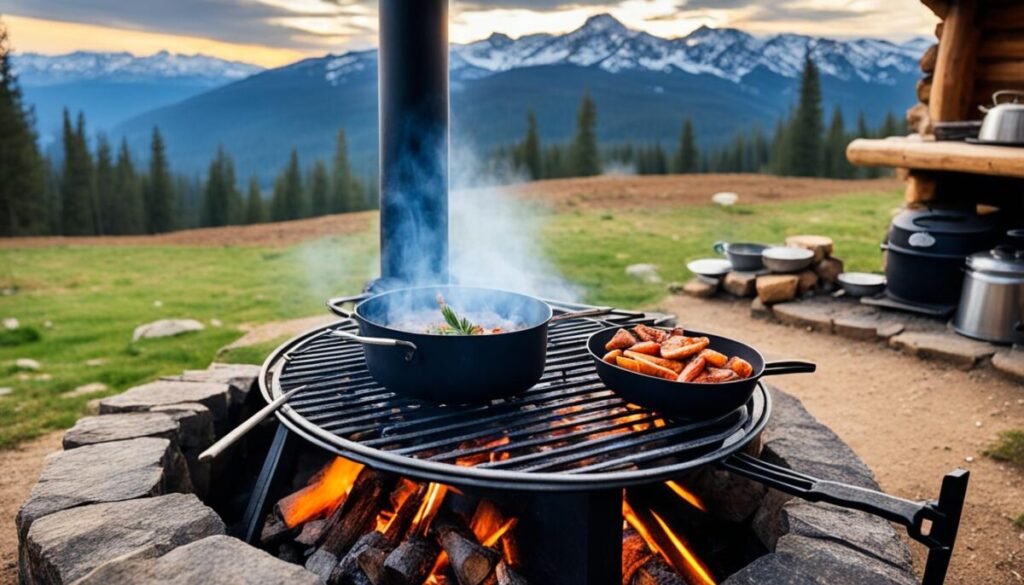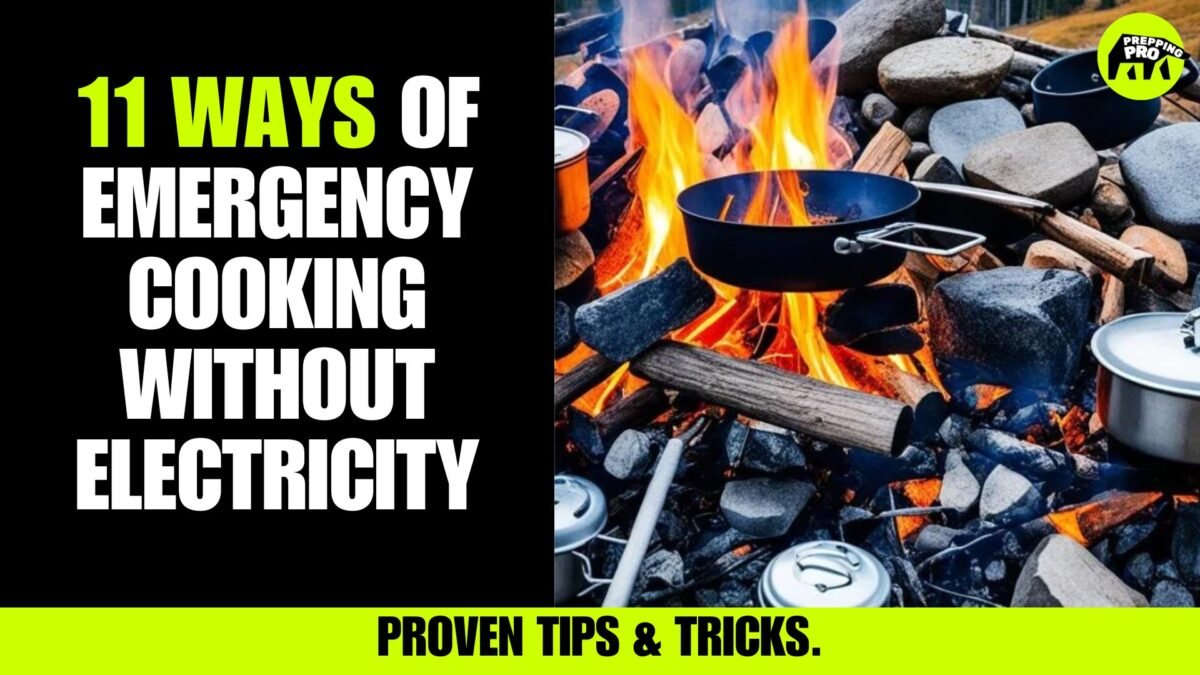“By failing to prepare, you are preparing to fail” – Benjamin Franklin
Amidst such circumstances, the ability to do emergency cooking without electricity enhances your survival quotient. This is where understanding and mastering off-grid cooking methods can prove invaluable.
In this article, we will build on the wisdom of the Reddit crowd and share eleven ways of emergency cooking without electricity.
What if you’re faced with a situation where you need to feed your family, but your electric stove doesn’t work, and there’s no delivery service? It’s time to go back to basics – experimenting with non-electric cooking techniques that ensure a hot meal on the table, irrespective of power availability.
Let’s get some wisdom from Reddit.
Table of Contents
Reddit Weighs In: Grilling Clear Winner
When disaster strikes and the power grid fails, one of the biggest challenges is cooking!
No electricity means no microwave, no stove.

But preppers have become masters of off-grid cooking strategies to keep those bellies full.
Objective: Through this case study, we’ll dive deep into real preppers’ hard-won wisdom for rustling up hot, nourishing meals sans power. Get ready to savor hot grub even when the flames are out and outlets are dead!
Background Information
- Context: This detailed case study examines multiple insightful threads from the r/preppers subreddit and related communities. The original questions sparked lively, passionate discussions on viable cooking options during extended blackouts, natural disasters or full off-grid scenarios.
- Community Profile: The prepper community takes emergency preparedness extremely seriously, constantly scheming and tinkering. Their resourceful ingenuity truly shines through these cooking threads, surfacing clever, inventive solutions for almost every situation imaginable.
Analysis of Discussion
- Key Points: Portable propane and butane camp stoves topped the recommendations for easy, reliable off-grid cooking. Charcoal and wood-fired grills also featured heavily, along with the ultra-efficient rocket stove design. More inventive options like DIY alcohol stoves and sun-powered solar ovens emerged as well.
- Data Visualization:

- Insights: A core insight was the importance of having redundancy – multiple backup cooking methods give vital flexibility. Preppers also stressed getting preps squared away now by stocking appropriate fuels, stoves and testing gear before you really need it.
Personal Stories/Quotes
- Contributor Highlight:
I’ll never forget when the power went out for 2 weeks after the hurricane. My little butane stove was an absolute lifesaver for boiling water and heating up freeze-dried meals.
Reddit User
- Differing Views: While many warned sternly against any indoor fires for safety, a few daring preppers admitted trying methods like tealight stoves in very well-ventilated areas. Weigh the risks carefully.
Practical Applications

Have a diverse cooking suite ready – stock up on propane canisters, charcoal, isopropyl alcohol and plenty of matches or lighters.

Grab a basic camp stove and high-efficiency rocket stove. Practice using them now.

Compactly store solid fuel cubes or hexamine tablets.

Scope out local fuel sources like fallen tree branches or brush. Always thoroughly test and get comfortable with any new cooking gear before relying on it when SHTF.
Conclusion
- Summary: Procuring hot, nutritious food becomes hugely challenging without that electricty we take for granted. But as these Reddit threads prove, it’s absolutely achievable with the right preparation and methods. We covered diverse solutions from propane stoves to biomass rockets to soak up these real preppers’ insights.
- Reflection: While simple in concept, these cooking methods require safety training and precautions. An ounce of prevention like fireproof mats and keeping extinguishers ready is wise. But overall, a little foresight empowers you to thrive during extended emergencies when others may struggle.
- Call to Action: I highly recommend taking time to review the full Reddit threads for even more specifics and ideas. Get started on your prepping now to ensure you can cook fulfilling meals without worry when the next crisis hits. And share your own off-grid cooking wins and hacks with us!
11 Ways of Emergency Cooking Without Electricity
When the lights go out and conventional cooking facilities are no longer an option, adaptability and resourcefulness become crucial skills. Fortunately, there are numerous ways to prepare a steaming, hot meal even without electricity. Here, we explore 11 ingenious and sometimes surprising emergency cooking hacks that keep your family nourished during a power outage.

Solar Cooker
Take advantage of the sun’s abundant energy with a solar cooker. This device harnesses sunlight, turning it into heat for cooking. Its efficiency shines brightest during sunny weather, but don’t worry too much about the clouds; some units store enough heat to cook even under overcast conditions.
Portable Gas Stoves
Portable gas stoves – be it butane, propane, or alcohol-based – are another great option. These units are easy to carry, giving you mobility and convenience. White gas stoves, although less user-friendly, stand out for their high heat output, enabling rapid cooking.
Wood-Burning Stoves
A wood-burning stove is a cherished companion in an emergency. Aside from their primary function as a cooking appliance, they provide a secondary source of heating for your space. Talk about hitting two birds with one stone!
Barbecue Grills
Don’t underestimate your trusty barbecue grill. In an emergency, propane or charcoal grills can be repurposed as powerful makeshift stove cooking stations. Just be sure to do your grilling outdoors for safety reasons.
Open-Fire
Rekindling the arts of our ancestors, open-fire cooking remains an effective method in times of crisis. Just be sure you have the right permissions and safeguards to burn fires outdoors safely.
Fireplace
Why not return your fireplace to its original cooking purpose? The flames that toast your marshmallows can also be used to heat your food, proving an incredible survival cooking strategy without power.
Engine Cooking
In truly dire straits, creativity can spark unexpected solutions. How about using the engine of your car to cook? Although unconventional, engine cooking can become an alternative cooking hack when other methods are not available.
Portable Cooking Bags
Portable cooking bags are a wonderful tool in situations where time is not critical. The just-add-water, leave-it-and-forget approach takes the convenience of emergency cooking to another level, freeing you to tackle other tasks at hand.
Tea Light Slow Cooker
Energy-efficient and compact, a tea light slow cooker offers a versatile and low-maintenance solution. It enables survival cooking without power, allowing you to prepare meals slowly with a minimal amount of fuel.
Earth Oven
If you’re in a rural area with access to natural resources, consider building an earth oven. This harkens back to the cooking methods of our forebears, using heated rocks as the primary heat source. It’s an excellent representation of resilience and adaptability during emergencies.
Hay Box Oven
Another innovative emergency cooking hack is the hay box oven. This is essentially nature’s version of a slow cooker. After initially heating your ingredients, you transfer them into the hay box, where they continue to cook from the retained heat. This way, you can maximize your fuel resources while still preparing delicious meals.
In short, there’s no need to despair when the electricity goes out. With the right knowledge, tools, and a bit of improvisation, your family can enjoy a hot meal with one of these survival cooking without power strategies. So, let’s embrace the spirit of resilience and keep cooking no matter what.
Understanding the Basics of Off-Grid Cooking Methods
Off-grid or non-electric cooking is not just a nod to traditional wisdom, but also a crucial survival skill during emergency situations when the standard power supply isn’t an option. This section attempts to enlighten the readers on why off-grid cooking methods and non-electric cooking techniques are essential and what key components you should have in your non-electric emergency kitchen.
Why Off-Grid Cooking is an Essential Skill
When we talk about emergency cooking without electricity, it all comes down to one principle: self-reliance. It’s about being able to feed yourself and your family in crises, even when regular electrical power sources are unavailable. This could range from severe weather events to long-term power outages. Knowing how to cook without electricity is a survival skill that enables you to remain nourished and sustained during such critical times.

Key Components of a Non-Electric Emergency Kitchen
A non-electric emergency kitchen is simple. It does not require complex equipment but rather resourcefulness and knowledge of some essential off-grid cooking methods. Here are some core components you should consider:
- Solar Ovens: Effectively harness the power of the sun to cook your meals. These are especially useful on sunny days and can effectively reach the right temperatures needed for cooking.
- Portable Gas Stoves: Propane, butane, white gas, and alcohol stoves offer a range of convenient options for outdoor cooking. They are lightweight, easy to carry, and the fuel is widely available.
- Wood-Burning Stoves: Apart from offering save off-grid cooking options, these stoves can also be used to keep your space warm.
- Barbecue Grills: If you have an outdoor space, barbecue grills can turn into vital cooking devices when electricity isn’t available.
- Open-Fire Setup: Traditional and reliable, this method allows for a variety of cooking techniques – from grilling to roasting and boiling.
- Fireplaces & Alcohol Stoves: For safe indoor cooking, these can be of great use. A fireplace, if available, can be used for roasting and grilling, and alcohol stoves are safe and practical.
Knowing how to use these alternative cooking methods effectively can be a game-changer in emergency situations. It makes you self-reliant, ensuring that you provide warm and nutritious meals for your family even when electricity is non-existent.
Emergency Cooking Without Electricity: Utilizing Solar Ovens and Gas Stoves
Imagine a sunny day without power. Now, no electricity doesn’t have to mean cold meals. In such situations, the art of solar oven cooking shines through. Solar ovens can effectively reach temperatures between 250 to 300 degrees on cloudless days, harnessing the sun’s energy to cook your meals.
Apart from solar ovens, portable gas stoves encompassing butane, propane, white gas, and alcohol stoves have evolved significantly. These stoves have emerged as efficient and convenient options for cooking during electricity outages. Each type of stove offers specific merits:
| Stove Type | Features |
|---|---|
| Butane Stoves | Lightweight and compact, they are perfect for portable needs. |
| Propane Stoves | They offer wide availability and reliability, making them a popular choice. |
| Alcohol Stoves | Known for their clean burn and safe usage, they are increasingly favoured. |
| White Gas Stoves | Quick to boil water, though they might require some practice to use efficiently. |
These emergency cooking hacks allow you to continue enjoying warm, home-cooked meals despite the lack of electricity. The choice of stove can be guided by individual preferences, availability of resources, and the specific situation at hand.
In conclusion, whether it’s by harnessing the power of the sun through a solar oven or using a portable gas stove, one thing is clear: a power outage doesn’t have to mean the end of warm meals. With these emergency cooking hacks, you can stay nourished and comforted even when the power is out.
Indoor Safe Emergency Cooking: Alcohol, Butane, and More
In times of emergency, having options for indoor cooking can become lifesaving. Indoor safe emergency cooking can be achieved through various methods, notably alcohol-based cooking solutions and efficient use of a butane stove. Each method requires careful planning and specific safety measures to prevent accidents.
Choosing the Right Alcohol-Based Solutions
Among the myriad of options for emergency cooking, alcohol-based solutions stand out as safe indoor-friendly alternatives. With alcohol fuels like denatured alcohol, pure ethanol, and rubbing alcohol, one can easily manage indoor cooking with proper ventilation. Care must be taken to avoid toxic alcohols like methanol, which can be harmfully intoxicating if ingested or inhaled.
Safely Using Butane for Indoor Cooking
Butane stoves are extensively used in camping and feature prominently in scenarios of non-electric cooking techniques. However, when using butane indoors, ensuring proper ventilation is paramount to prevent the build-up of harmful gases such as carbon monoxide. Appliances like Dometic’s Origo Heat Pal 5100, a combined alcohol space heater and stove, provide a safe, compact solution for indoor emergencies.
Precautions and Safety Measures for Indoor Cooking
A key aspect of indoor safe emergency cooking revolves around taking a set of precautions. These include proper ventilation, carbon monoxide monitoring, and practicing safe fire handling and extinguishing techniques. Regular practice and proficiency in your chosen indoor cooking methods can help prevent accidents and make the best use of available resources during emergencies.
| Fuel Type | Benefits | Precautions |
|---|---|---|
| Alcohol-Based | Safe for indoor use with adequate ventilation. Fuel types like denatured alcohol, ethanol, and rubbing alcohol are widely available. | Avoid toxic alcohols like methanol. Monitor for proper ventilation to prevent carbon monoxide build-up. |
| Butane | Easy to use, efficient heat production, ideal for camping or emergencies. Products like Dometic’s Origo Heat Pal 5100 combine heating and cooking capabilities. | Ensure proper ventilation when used indoors, monitor for carbon monoxide. Always have an extinguishing plan. |
Maximizing Minimal Resources: Creative and Makeshift Stove Cooking
When emergencies arise and our normal conveniences are stripped away, creative and makeshift stove cooking becomes a beacon of hope. Everyday items, limited fuel supplies, and natural elements offer unique opportunities in these trying times, standing as testament to our ability to adapt, innovate, and survive.
Repurposing Everyday Items for Cooking
Kitchen cabinets and pantries may hold unexpected solutions during crises. A simple tuna can, for instance, can be transformed into a useful stove. Paper clips, alcohol fuel, and matches can turn this common pantry item into a relief during a power outage. On the other hand, portable cooking bags that utilize heat-generating, non-toxic chemical reactions offer a promising alternative that require no electricity, gas, or fire, defining makeshift stove cooking in its most innovative form.
Making the Most of Limited Fuel Supplies
The principle of doing more with less shines in a survival situation. Tea light slow cookers, for instance, require minimal energy, slow-cooking meals over multiple hours, perfect for stews and soups. Hay box ovens, on the other hand, use the principle of heat retention. After an initial heat source, such as a boiling pot, is placed inside it, the hay box retains the heat, allowing for cooking or reheating without constant fuel use. These creative emergency cooking hacks emphasize the importance of maximizing minimal resources, demonstrating that ingenious solutions often lie in places least expected.
Finding Alternative Cooking Methods in Nature
When all else fails, we turn back to nature. The earth itself becomes our oven. Earth ovens, which are essentially pits in the ground used as ovens, utilize heated stones as their primary heat source. Similarly, stick bread, made by wrapping a simple dough around a stick and holding it over embers, is another method harking back to our ancestors. These alternative cooking methods during emergencies step in when modern conveniences step out, proving the resilience of human resourcefulness.
| Method | Materials Needed | Pros | Cons |
|---|---|---|---|
| Makeshift Tuna Can Stove | Tuna can, paper clips, matches, alcohol fuel | Portable and cost-effective | Limited cooking time, small heat source |
| Tea Light Slow Cooker | Tea light candles, slow cooker pot, grill rack | Minimal resource usage | Slow cooking process |
| Hay Box Oven | Hay or straw, box, pot with lid | Conserves heat and fuel, can keep food warm for hours | Initial heat source required |
| Earth Oven | Ground pit, heated stones, prepared food | No need for electricity or modern appliances | Extended cooking time, dependent on weather |
Conclusion
The art of emergency cooking without electricity truly hinges upon human ingenuity and resourcefulness. Through various methods discussed, we’ve navigated from harnessing the abundant power of the sun to the convenience of portable gas stoves, the familiarity of the open fire, and the innovation of tea light slow cookers and earth ovens.
What remains paramount across all these off-grid cooking methods is the realization that being able to cook without electricity is not merely a matter of sustenance during power outages. It’s a mark of strengthened self-reliance and resilience, a testament to our survival instincts and adaptation skills.
In closing, never overlook the importance of safety procedures, maintaining proper ventilation, and staying abreast of the risks posed by carbon monoxide when exploring these emergency cooking hacks. Having a well-planned non-electric cooking strategy and an adequate emergency food stockpile, in line with CDC recommendations, are essential preparations. Taking the time to perfect these cooking techniques without power marks a significant step towards preparedness, ensuring survival when faced with real-world emergencies.


